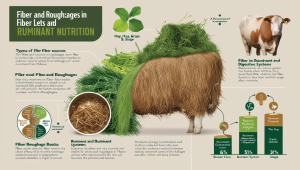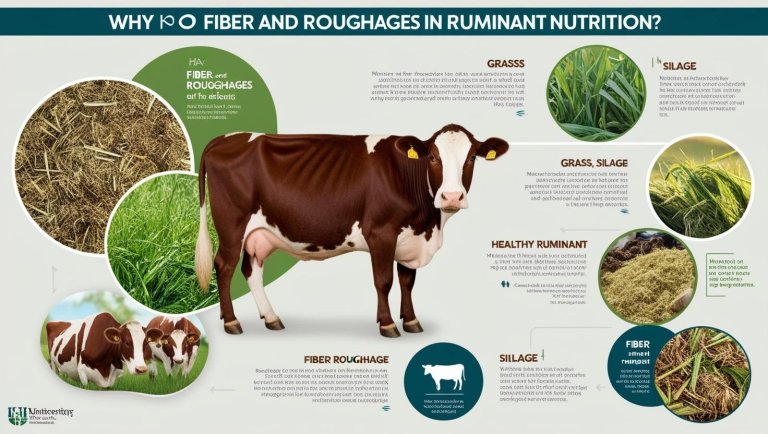Ruminant animals, such as cattle, sheep, and goats, have a unique digestive system that allows them to efficiently utilize plant-based diets. Their digestive tract, particularly the rumen, is adapted to break down fibrous plant material, making fiber and roughages essential components of their nutrition. Understanding the significance of fiber and roughages in ruminant diets is crucial for maintaining their health, productivity, and overall well-being.
Understanding Fiber and Roughages
Fiber is a crucial part of a ruminant’s diet and primarily consists of structural carbohydrates such as cellulose, hemicellulose, and lignin. These components form the structural parts of plants and provide bulk to the diet. Roughages, a term often used interchangeably with fiber sources, include forages such as hay, silage, straw, pasture grasses, and crop residues. These materials are rich in fiber and are necessary for proper rumen function and digestive health.
READ ALSO: Beef Cattle Farming: Breeds, Housing, and Management
The Role of Fiber in Ruminant Nutrition
1. Promotes Rumen Health and Function
Fiber plays a significant role in stimulating rumen activity. The rumen contains a diverse population of microorganisms, including bacteria, protozoa, and fungi, which break down fibrous plant materials through fermentation. This microbial fermentation produces volatile fatty acids (VFAs) such as acetate, propionate, and butyrate, which serve as the primary energy sources for ruminants.
2. Supports Proper Digestion and Prevents Acidosis
A diet rich in fiber encourages cud chewing and saliva production, which helps buffer the rumen’s pH. When ruminants consume high-energy, low-fiber diets, their rumen pH can drop significantly, leading to acidosis. Acidosis is a serious metabolic disorder that can result in reduced feed intake, poor growth rates, and even death in severe cases. Fiber helps maintain a stable rumen environment by slowing digestion and enhancing salivation.
3. Enhances Feed Efficiency and Nutrient Utilization
The digestion of fiber by rumen microbes produces end products that the ruminant can absorb and utilize. While fiber itself is not directly digestible by the animal, the microbes in the rumen break it down into usable energy. This process ensures that ruminants efficiently convert low-quality forages into valuable nutrients.
4. Prevents Digestive Disorders
Fiber aids in gut motility and prevents common digestive issues such as bloat and displaced abomasum. Bloat, caused by excessive gas accumulation in the rumen, is more prevalent in diets that lack sufficient roughage. Adequate fiber intake ensures steady gas release and proper functioning of the digestive tract.
READ ALSO: Stress Management in Livestock
Types of Roughages and Their Nutritional Value

1. Fresh Forages (Pasture Grasses and Legumes)
Pastures provide highly nutritious roughages, especially when they include legumes like alfalfa and clover. These fresh forages offer balanced protein, fiber, and minerals, supporting growth, reproduction, and milk production.
2. Hay
Hay is dried forage that retains much of its nutritional value when properly harvested. Common types include timothy hay, Bermuda grass hay, and alfalfa hay. It is a vital source of fiber, particularly in seasons when fresh pasture is unavailable.
3. Silage
Silage is fermented green forage stored under anaerobic conditions. It is rich in energy and digestible fiber and helps provide consistent nutrition, especially during dry seasons. Corn silage and grass silage are commonly used in ruminant diets.
4. Crop Residues (Straw and Stover)
Crop residues such as wheat straw and maize stover are lower in protein but provide essential fiber. These roughages are particularly useful in regions where high-quality forages are scarce.
READ ALSO: Strategies to Ensure Adequate Water Supply for Livestock and Poultry
Balancing Fiber in Ruminant Diets

While fiber is essential, excessive fiber intake without adequate protein and energy can limit animal performance. It is crucial to balance roughages with concentrates (grains and protein supplements) to meet the specific needs of growing, lactating, and finishing animals. The ideal fiber content in a ruminant’s diet depends on factors such as age, production stage, and breed.
Conclusion
Fiber and roughages play a fundamental role in ruminant nutrition by promoting rumen health, preventing digestive disorders, and enhancing feed efficiency. Proper management of roughage intake ensures optimal productivity, whether in dairy production, meat production, or general livestock husbandry. Understanding the importance of fiber and roughages allows farmers and animal nutritionists to formulate diets that support healthy and productive ruminant animals.
READ ALSO: TIPS TO PREVENT THEFT ON FARM
Poultry theft and pilfering is an increasingly serious and prevalent problem, there are a number of ways to help protect your animals, products, and property and deter thieves. Many of these measures are simple to implement and relatively affordable, especially when compared to the cost of a burglary, so it’s certainly worthwhile. Here are six ways you can protect your farm and property from theft…
READ ALSO: Parasites in Livestock and Poultry: Identification and Control
Parasites are a major concern in livestock and poultry farming, affecting the health, productivity, and overall well-being of animals. They can cause a wide range of issues, from mild irritation to severe diseases, leading to economic losses due to reduced growth rates, poor feed conversion, lower milk or egg production, and even death in severe cases. Controlling parasites is essential for maintaining a healthy herd or flock…
Click HERE to join our WhatsApp group

